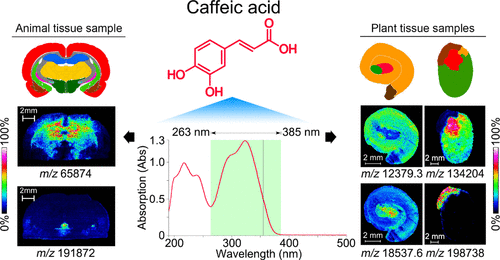当前位置:
X-MOL 学术
›
Anal. Chem.
›
论文详情
Our official English website, www.x-mol.net, welcomes your
feedback! (Note: you will need to create a separate account there.)
A Caffeic Acid Matrix Improves In Situ Detection and Imaging of Proteins with High Molecular Weight Close to 200,000 Da in Tissues by Matrix-Assisted Laser Desorption/Ionization Mass Spectrometry Imaging
Analytical Chemistry ( IF 6.7 ) Pub Date : 2021-08-18 , DOI: 10.1021/acs.analchem.0c05480
Haiqiang Liu 1, 2 , Manman Han 1, 2 , Jinming Li 1, 2 , Liang Qin 1, 2 , Lulu Chen 1, 2 , Qichen Hao 1, 2 , Dongxu Jiang 1, 2 , Difan Chen 1, 2 , Yuanyuan Ji 2 , Hang Han 2 , Chunlin Long 2 , Yijun Zhou 2 , Jinchao Feng 2 , Xiaodong Wang 1, 2
Analytical Chemistry ( IF 6.7 ) Pub Date : 2021-08-18 , DOI: 10.1021/acs.analchem.0c05480
Haiqiang Liu 1, 2 , Manman Han 1, 2 , Jinming Li 1, 2 , Liang Qin 1, 2 , Lulu Chen 1, 2 , Qichen Hao 1, 2 , Dongxu Jiang 1, 2 , Difan Chen 1, 2 , Yuanyuan Ji 2 , Hang Han 2 , Chunlin Long 2 , Yijun Zhou 2 , Jinchao Feng 2 , Xiaodong Wang 1, 2
Affiliation

|
To our knowledge, this was the first study in which caffeic acid (CA) was successfully evaluated as a matrix to enhance the in situ detection and imaging of endogenous proteins in three biological tissue sections (i.e., a rat brain and Capparis masaikai and germinating soybean seeds) by matrix-assisted laser desorption/ionization mass spectrometry imaging (MALDI-MSI). Our results show several properties of CA, including strong ultraviolet absorption, a super-wide MS detection mass range close to 200,000 Da, micrometer-sized matrix crystals, uniform matrix deposition, and high ionization efficiency. More high-molecular-weight (HMW) protein ion signals (m/z > 30,000) could be clearly detected in biological tissues with the use of CA, compared to two commonly used MALDI matrices, i.e., sinapinic acid (SA) and ferulic acid (FA). Notably, CA shows excellent performance for HMW protein in situ detection from biological tissues in the mass range m/z > 80,000, compared to the use of SA and FA. Furthermore, the use of a CA matrix also significantly enhanced the imaging of proteins on the surface of selected biological tissue sections. Three HMW protein ion signals (m/z 50,419, m/z 65,874, and m/z 191,872) from a rat brain, two sweet proteins (mabinlin-2 and mabinlin-4) from a Capparis masaikai seed, and three HMW protein ion signals (m/z 94,838, m/z 134,204, and m/z 198,738) from a germinating soybean seed were successfully imaged for the first time. Our study proves that CA has the potential to become a standard organic acid matrix for enhanced tissue imaging of HMW proteins by MALDI-MSI in both animal and plant tissues.
中文翻译:

咖啡酸基质通过基质辅助激光解吸/电离质谱成像改进组织中接近 200,000 Da 的高分子量蛋白质的原位检测和成像
据我们所知,这是第一项成功评估咖啡酸 (CA) 作为基质以增强三个生物组织切片(即大鼠脑和Capparis masaikai和发芽大豆)中内源性蛋白质的原位检测和成像的研究。种子)通过基质辅助激光解吸/电离质谱成像(MALDI-MSI)。我们的结果显示了 CA 的几个特性,包括强紫外线吸收、接近 200,000 Da 的超宽 MS 检测质量范围、微米级基质晶体、均匀的基质沉积和高电离效率。更多高分子量 (HMW) 蛋白质离子信号 ( m / z与两种常用的 MALDI 基质,即芥子酸 (SA) 和阿魏酸 (FA)相比,使用 CA 可以在生物组织中清楚地检测到 > 30,000 )。值得注意的是,与使用 SA 和 FA 相比,CA在质量范围m / z > 80,000内从生物组织中原位检测HMW 蛋白表现出优异的性能。此外,CA 矩阵的使用还显着增强了所选生物组织切片表面上的蛋白质成像。三个 HMW 蛋白质离子信号(m / z 50,419、m / z 65,874 和m / z191,872) 来自大鼠脑,两种甜蛋白(mabinlin-2 和 mabinlin-4)来自Capparis masaikai种子,以及三种 HMW 蛋白质离子信号(m / z 94,838、m / z 134,204 和m / z 198,738)来自发芽的大豆种子首次成功成像。我们的研究证明,CA 有可能成为标准有机酸基质,用于通过 MALDI-MSI 在动物和植物组织中增强 HMW 蛋白的组织成像。
更新日期:2021-09-07
中文翻译:

咖啡酸基质通过基质辅助激光解吸/电离质谱成像改进组织中接近 200,000 Da 的高分子量蛋白质的原位检测和成像
据我们所知,这是第一项成功评估咖啡酸 (CA) 作为基质以增强三个生物组织切片(即大鼠脑和Capparis masaikai和发芽大豆)中内源性蛋白质的原位检测和成像的研究。种子)通过基质辅助激光解吸/电离质谱成像(MALDI-MSI)。我们的结果显示了 CA 的几个特性,包括强紫外线吸收、接近 200,000 Da 的超宽 MS 检测质量范围、微米级基质晶体、均匀的基质沉积和高电离效率。更多高分子量 (HMW) 蛋白质离子信号 ( m / z与两种常用的 MALDI 基质,即芥子酸 (SA) 和阿魏酸 (FA)相比,使用 CA 可以在生物组织中清楚地检测到 > 30,000 )。值得注意的是,与使用 SA 和 FA 相比,CA在质量范围m / z > 80,000内从生物组织中原位检测HMW 蛋白表现出优异的性能。此外,CA 矩阵的使用还显着增强了所选生物组织切片表面上的蛋白质成像。三个 HMW 蛋白质离子信号(m / z 50,419、m / z 65,874 和m / z191,872) 来自大鼠脑,两种甜蛋白(mabinlin-2 和 mabinlin-4)来自Capparis masaikai种子,以及三种 HMW 蛋白质离子信号(m / z 94,838、m / z 134,204 和m / z 198,738)来自发芽的大豆种子首次成功成像。我们的研究证明,CA 有可能成为标准有机酸基质,用于通过 MALDI-MSI 在动物和植物组织中增强 HMW 蛋白的组织成像。

































 京公网安备 11010802027423号
京公网安备 11010802027423号